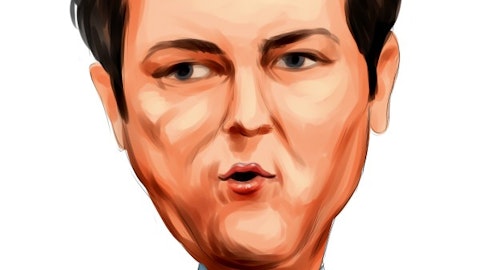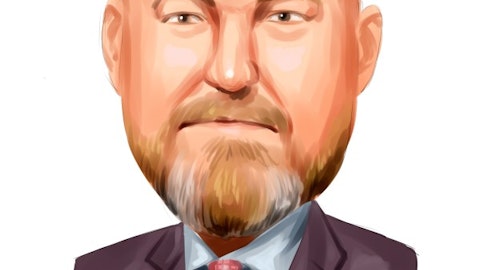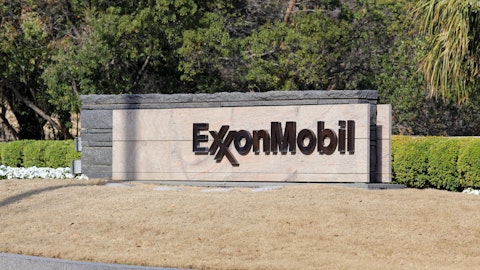The Western Union Company (NYSE:WU) Q4 2022 Earnings Call Transcript February 7, 2023
Operator: Good day, and welcome to the Western Union Fourth Quarter and Full Year 2022 Results Conference Call. All participants will be in a listen-only mode. After today’s presentation there will be an opportunity to ask questions. Please note this event is being recorded. I would now like to turn the conference over to Brad Windbigler, Head of Treasury and Investor Relations. Brad, please go ahead.
Brad Windbigler: Thank you. On today’s call, we will discuss the company’s fourth quarter 2022 results, our financial outlook for 2023, and then we will take your questions. The slides accompany this call and webcast can be found at westernunion.com under the Investor Relations tab and will remain available after the call. Additional operational statistics have been provided in supplemental tables with our press release. On our call today is our CEO, Devin McGranahan; and our CFO, Matt Cagwin. Today’s call is being recorded, and our comments include forward-looking statements. Please refer to cautionary language in the earnings release and in Western Union’s filings with the Securities and Exchange Commission, including the 2021 Form 10-K for additional information concerning factors that could cause actual results to differ materially from the forward- looking statements.
During the call, we will discuss some items that do not conform to generally accepted accounting principles. We have reconciled those items and the most comparable GAAP measures in our earnings release attached to our Form 8-K as well as on our website, westernunion.com, under the Investor Relations section. I will now turn the call over to our CEO, Devin McGranahan.
Devin McGranahan: Good afternoon, and welcome to Western Union’s fourth quarter 2022 financial results conference call. Our reported revenue in the fourth quarter was $1.1 billion, and excluding contributions from Business Solutions, decreased 6% on a constant currency basis. This growth reflects a negative impact of 3 percentage points from the suspension of operations in Russia and Belarus continued softness in our retail business as well as our new branded digital marketing strategy, which includes promotional pricing. Adjusted earnings per share was $0.32 in the quarter compared with $0.64 in the prior year period, which included a contribution of $0.08 from Business Solutions and $0.06 from operations in Russia and Belarus.
The decrease in adjusted EPS was driven lower by lower operating profit and a $0.05 negative currency impact and a higher effective tax rate, partially offset by lower share count. We continue to focus on maximizing cash flow and on returning capital to our shareholders. In 2022, we returned over $700 million to the shareholders, including $175 million of share buyback in the fourth quarter. Matt will further discuss our financial results in more detail and provide an update on our 2023 financial outlook. On the macro front, 2022 is a challenging year for many businesses with interest rates rising to the highest levels in over a decade and global inflation at the highest point in multiple decades. Despite that backdrop, our customers continued to show their resilience with constant currency principal per transaction up 4% in the fourth quarter and the full year.
The IMF updated their global growth forecast last week. They now expect GDP growth of 2.9% in 2023, which will be down from 3.4% in 2022. We have come to believe that remittance volume closely tracks with global GDP growth. As such, global remittance volume continues to remain strong, according to the World Bank’s most recent migration and development brief, which was published in November. They estimated that global remittance flows to the low and middle income countries grew at 5% in ’22 and project a further 2% growth in 2023. We continue to monitor macroeconomic variables that could influence our business, but our expectation is that the backdrop for 2023 will remain similar to what we have experienced in 2022, and we have included these assumptions in our 2023 outlook.
Last October, we launched Evolve 2025 strategy to return Western Union to growth by becoming the market leader in providing accessible financial services to the aspiring populations of the world. To achieve this goal, we have been working to revitalize our core retail and digital remittance businesses in launch new products and services to expand our value proposition to our 120 million plus customers around the world. In August, we outlined our plan to accelerate investment in the back half of the year. We achieved this goal with increased investment in our technology platforms and in our digital marketing. These investments are focused on building core new technology to better enable world-class customer and agent experiences. As we highlighted yesterday, improving customer retention is an important driver of returning Western Union to positive growth.
We are laser-focused on creating world-class experiences across our channels and products that will make it easier for customers to want to transact with us the first time and every time after. While our investment levels were heavier in the fourth quarter than I would expect on an ongoing basis, we recognized that in order to compete with many of our digital-first competitors, we need comparable customer experiences. And we’ll want to continue to iterate and innovate every step of the customer journey. A few notable examples of investments in the fourth quarter include: First, in our digital bank, in February of 2022, we launched a digital bank in Germany and Romania with the goal of creating a digital wallet-based payment platform. As we evolve our model from a transaction-based relationship to an account-based relationship, we expect to see increased customer engagement through more frequent interactions and ultimately improve customer retention.
We believe an account-based model will provide us with a better platform also for the expansion of new products and services. In Q3, we expanded our digital bank offering to Poland, and in Q4, we added Italy. By ending send-and-receive country pairs, we are experimenting with how this approach can maximize the benefits of our 2-sided network. The project is progressing. And the countries we have now launched, we have a total of approximately 150,000 onboarded customers. Our goal for 2023 is to expand our digital wallet and financial ecosystem to a number of additional markets. And in the fourth quarter, we made investments to enable us to launch our digital wallet in 2 additional European countries as well as our first 2 launches outside of Europe, including the United States, the largest remittance end market in the world; and Brazil, the largest economy in Latin America.
In addition to our digital bank, in the quarter, we also still continued the development of our new retail point-of- sale system. We believe this new POS will improve both agent and customer experience and will help change the trajectory of our retail business. We began a pilot of the new POS in select locations in the U.S. in December. And we believe that removing friction from our retail transaction process will improve not only transaction abandonment rates but will allow our agent partners to serve more customers, ultimately creating a better experience for both our agents and our customers. Finally, driven by our new go-to-market strategy in the U.S., we made the decision to invest increased investment in our marketing program in digital customer acquisition in the fourth quarter so that we could test and learn.
We added additional dollars behind the strategy in the United States and also rolled out similar strategic programs in a few European markets as we continue to scale the program worldwide. As we discussed at Investor Day, returning our digital business to positive customer and transaction growth is our top priority. We are shifting our approach for maximizing revenue per transaction, maximizing customer acquisition and growing customer lifetime value. This change has required us to rethink our approach to new customer offers and our approach to maximizing top-of-funnel effectiveness on every marketing dollar. I am pleased to tell you we believe it is working. We reported to you last quarter that new U.S. outbound branded digital customers increased 26% year-over-year in the month of September.
Today, I am pleased to report that, that momentum we saw in September continued through the fourth quarter with new U.S. outbound branded digital customers up 30% year-over-year, which is now contributing to an improvement in our transaction trends as well. In Q4, we saw U.S. outbound branded digital transactions grow at 5%, a clear reversal of the decelerating trends we’ve seen in the business earlier in the year and the fastest transaction growth rate since the fourth quarter of 2021. Growing customers and transaction is important, but so is increasing customer lifetime value. In the near term, increasing retention is the lever and our focus. By simplifying repeat send experiences and increasing our ongoing CRM efforts, we are starting to see improvements.
As a case example, if we look at fourth quarter retention rates for our newly acquired U.S. outbound September cohort, going back several years for comparison, the 90-day retention rate for that cohort is the highest we’ve ever seen. Not only are we acquiring now more U.S. outbound branded digital customers, but we are retaining those customers at a higher rate than we have in the past. While it is clearly too early to definitively say what the ultimate lifetime value of these new customers will be. Early results show promise as typically around 75% of the full year retention value is captured in the 90-day retention rate. Given what we are seeing with transaction growth and retention rates among this new cohort, we believe these new customers are clearly value accretive even at a lower revenue per transaction.
The last topic that I’d like to discuss is the success we are seeing in Latin America, which has continued to perform with double-digit revenue growth in the fourth quarter. Latin America is a great example of where we are improving our distribution both via owned locations in conjunction with our agent partners. As we discussed on the second quarter call, our corporate-owned locations in Brazil, while only 5% of our retail footprint, accounted for over 50% of the revenue in that country. In 2022, we opened over 50 new corporate- owned locations in Latin America, including new locations in Argentina, Peru and Brazil. Given the right mix of distribution like we have in Latin America, we are seeing results. In Q4, LACA saw 16% new cross-border customer growth with cross-border monthly active users up 11%.
Marginally increasing our footprint of exclusive Western Union branded corporate-owned and concept stores in high-volume locations allows us to better control the customer experience, increase the number of products and services we offer, promote the retail to digital escalator, and assist with the eventual adoption of our digital wallet and our financial ecosystem. Importantly, we are able to add these kinds of locations at attractive economics with low capital and oftentimes generate above corporate average operating margins. Our goal is to concentrate corporate-owned and concept stores in high-density areas of the network while continuing to maintain and expand our extremely broad and valuable agent footprint. Given the success we have seen in Latin America, our plan for 2023 is to open another 50 corporate-owned locations in the region and also expand this model of controlled distribution into other parts of our network.

Photo by Alistair MacRobert on Unsplash
Europe in 2022, we opened 15 new concept stores across the region and 1 new corporate-owned location in the Central Madrid train station. In a quick update, Melody, our partner in Rome that we highlighted at Investor Day, will now have 7 stores live, branded Western Union, that includes a new store in Italy that she is opening this week. She and we together are enabling us to better serve the Filipino community across Europe. Before I turn the call over to Matt to discuss our financial results in more detail, I would like to highlight a few key partnerships. First, we are pleased to announce the signing of 7-Eleven stores across Mexico. Mexico is one of the largest inbound remittance markets in the world. And we look forward to offering our remittance services at over 1,800,711 locations across the country.
Next, we are pleased to announce the extension of our long-term and exclusive relationship with the Rite Aid, signing a new 5-year partnership. Rite Aid is one of the leading consumer retail stores in the United States and a long-term valuable partner of Western Union. Finally, I’m very pleased to announce that Matt Cagwin was appointed the Chief Financial Officer of Western Union. Matt joined us in July of last year as the Head of Business Unit Financial Planning and Analysis and served as the interim CFO since September. Matt brings a wealth of experience to the role, most recently serving as the CFO of the Merchant Acceptance division of Fiserv First Data. Thank you for your time, and I will now turn the call over to Matt.
Matthew Cagwin: Thank you, Devin. And good afternoon, everyone. I’m pleased to be here with you today to walk through our fourth quarter results and our 2023 financial outlook. Information for the full year results can be found in our press release and the attached financial schedules. Fourth quarter results were in line with our expectations and our 2022 adjusted full year financial outlook, although well below what we believe to be our long-term potential. Overall, 2022 was a challenging year with the start of the conflict between Russia and the Ukraine, the increase in macroeconomic uncertainty given high inflation, rising interest rates and slowing global economy. We also announced the migration of 2 key retail European agents, the first of which that took effect in Q4.
While headwinds will continue into 2023, we are confident that we can move the needle in the right direction as we continue to lay the building for our Evolve 2025 strategy. We’ll go through our 2023 outlook in more detail shortly. Before I do that, let’s move into the fourth quarter results. Fourth quarter adjusted revenue was down 6% to $1.1 billion. The suspension of our operations in Russia, Belarus impacted the revenue by 3%. Q4 included a number of dynamics, including the net impact of promotional pricing activities, and the loss of a European agent, which negatively impacted our revenue by 2% in the quarter and was partially offset by the growth of other and a 1% benefit from Argentina inflation. Adjusted operating margin was 15.8% in the quarter compared to 24.9% last year, which was positively impacted by 60 basis points from the inclusion of Business Solutions last year.
Full year operating margin was 20.4%, landing in the midpoint of our range of our outlook. As Devin highlighted earlier, we accelerated investment in the quarter, supporting our Evolve 2025 strategy, including the expansion of our financial ecosystem, the implementation, scaling of our new go-to-market branded digital strategy and the design and build of our new point-of-sale system. The decrease in fourth quarter operating margin was driven by lower revenue, the rollout of our new brand digital strategy as well as the increase in technology investments. The adjusted effective tax rate in the quarter was 14.7% compared to 12.1% in the prior year period. The increase in adjusted effective tax rate was primarily due to discrete tax benefits in the prior year period.
Now moving on to adjusted EPS, which was $0.32 in the quarter compared to $0.64 in the prior year period. The decrease in adjusted EPS was primarily driven by lower operating profits, a $0.05 negative impact of currency, a higher effective tax rate, partially offset by lower share count. Additionally, in the prior year period, Business Solutions and operations in Russia, Belarus contributed $0.08 and $0.06, respectively. And now turning to our C2C segment. Revenue decreased 9% on a constant currency basis, driven by softness in our retail business and promotional activities related to our new branded digital go-to-market strategy. Transactions in our C2C segment declined 12% in the quarter. Russia, Belarus negatively impacted revenue and transactions by 3 percentage points and 9 percentage points, respectively.
When you look at our branded digital business, revenue declined 6% on a constant currency basis. In contrast, transactions grew 2% by our new go-to-market strategy, which was launched in the U.S. during the third quarter. Earlier, Devin spoke about how our strategy drove a 30% growth in new U.S. outbound branded digital customers in the quarter and reversed a decelerating transaction trend that we have seen in the business for a number of quarters. And in the fourth quarter, global new branded digital customers grew approximately 14%. Now moving on to the regional results. In the fourth quarter, North America continued to decrease 7% while transactions declined 2%. The U.S. domestic business and the U.S. outbound business to Russia continued to be a drag on our results.
While revenue was also adversely affected by 4% from the promotional price activity in the quarter, as discussed earlier. We were pleased by the continued momentum that we saw in our new U.S. outbound branded digital customers. We saw a 3 percentage point transaction growth in North America brand into digital business, which was a 600 basis point improvement versus Q3, which we believe is another proof point that our strategy is moving us in the right direction. Revenue in Europe and CIS region was down 17% on a constant currency basis with transaction declines of 31%. Russia and Belarus adversely impacted adjusted revenue by 8 percentage points and transactions by 26 percentage points. The region continues to face difficult macro backdrop, competitive pressures and was impacted by the loss of a key retail agent during the quarter.
Even with the agent loss, revenue trends improved in the fourth quarter versus the first half of the year, excluding the impact of Russia and Belarus. Revenue in the Middle East, Africa, South Asia region, on a constant currency basis, while transactions decreased 5%. Softness in retail and digital-right label businesses were partially offset by growth in our branded digital business. Revenue growth in Latin America and Caribbean regions accelerated and was up 13% in the quarter on a constant currency basis with transaction growth of 8%. The solid performance in the quarter was led by strength in Ecuador, Venezuela and Nicaragua. And finally, revenue in APAC region was down 14% on a constant currency basis, with transaction declines of 12% due to softness in Australia, Japan and Korea.
Now turning to other revenue, which primarily consist of retail bill payments in Argentina and the United States and retail money order in the U.S., which represents 7% of the total company revenue and grew 20% year-over- year on a reported basis. During the fourth quarter, we completed the closing of the second closing of business solution divestiture, transferring the United Kingdom operations. The third closing, which includes the European operations, is currently expected to occur in the second quarter of 2023, subject to regulatory approvals. As a reminder, we’ve already received the full proceeds from the sale. Now turning to cash flow and balance sheet. In 2022, we generated $582 million of operating cash flow, which included a transition tax payment of $64 million paid in the second quarter.
These transition tax payments resulted from 2017 U.S. Tax Act and will increase annually over the next 3 years and stop after 2025. In 2022, we also returned $713 million to shareholders through a combination of dividends and share repurchases, continuing our strong track record to return capital to our shareholders. Today, we announced that our Board of Directors approved a $0.235 quarterly dividend payable on March 31, 2023. We also went up our capital expenditures, which were down — which were $208 million in 2022, which was down 3% versus 2021, with a mix shifting from agent signing bonuses to more software development. And finally, at the end of the quarter, we have cash and cash equivalents of $1.3 billion and debt of $2.6 billion, down roughly $400 million from a year ago.
With our leverage ratio now sitting at 2.4 times and 1.2 times on a net basis, which supports our strong balance sheet position and provides us flexibility for potential M&A while we target to maintain our investment-grade credit rating. And then finally, as part of our ongoing operating expense deployment program to optimize our expense base, in 2022, we invested approximately $50 million. This program allowed us to increase our funding in various strategic initiatives like building out our digital wallet, our financial ecosystem and creating our new point-of-sale system, enhancing our digital transaction platform, and creating an integrated omnichannel experience. We are already making good progress on reallocating expenses in 2023, and I look forward to providing additional updates as the year progresses.
Now moving to our outlook. Today, we reaffirmed the 2023 adjusted financial outlook we provided at our 2022 Investor Day. Our outlook assumes no major changes in macroeconomic conditions, including changes in foreign currency. We expect adjusted revenue to be down 2% to 4%. As I mentioned earlier, 2023 will face headwinds from Russia, Belarus in Q1 and the loss of 2 European agents throughout the year. We expect the adjusted operating margin to be in the range of approximately 19% to 21%. In the first half of 2023, we expect margins to be below our full year range as we continue to make product investments, expense redeployment related to our cost efficiency program and lapping the impact of Russia and Belarus. And finally, adjusted EPS is expected to be in the range of $1.55 to $1.65.
Expected year-over-year decrease in adjusted EPS includes $0.18 related to the sale of Business Solutions, agent losses, Russian and Belarus and currency impacts. Lastly, we would like to provide an update on our 4 key performance indicators that we talked about at Investor Day. In 2022, we improved retail retention by 46 basis points year-over-year. Our goal is to improve this metric by 200 basis points annually, driven by technology improvements, and improvements in our agent and customer experience. Our second performance goal is to grow our new branded digital customers by double digit. Given the success of our new branded digital go-to-market strategy, I’m pleased to report that we’ve achieved a 14% new customer growth in the fourth quarter.
Our third KPI is a 20% omnichannel customer growth. This metric was flat year-over- year in 2022, in line with our assumptions as we believe we need to make improvements to our customer journey and loyalty programs before we’ll be able to meaningfully improve our omnichannel customer growth. And finally, the last center we talked about at Investor Day was our ecosystem. Our ecosystem added 15,000 customers a month on average over the past 3 months. We believe our longer-term goal of 100,000 a month will be possible with the rollout of large consumer bases like the United States, Brazil, and we look forward to launching our digital wallet in those countries in the coming quarters. To recap, last year, we delivered our adjusted full year financial outlook and launched our Evolve 2025 strategy, which aims to put us on a path toward sustainable long-term growth.
So far, we’ve made good progress on laying the foundation of our strategy, including accelerating investments and look forward to providing more updates as we continue our journey. Thank you for joining our call today. And operator, now we’re ready to take questions.
See also 25 Most Famous Companies in the World and 25 Countries with the Most Billionaires.
Q&A Session
Follow Western Union Co (NYSE:WU)
Follow Western Union Co (NYSE:WU)
Operator: Our first question comes from Tien-Tsin Huang from JPMorgan. Please ask your question.
Tien-Tsin Huang: I appreciate you guys going through all the detail here. So the LACA acceleration, I thought that was really interesting. You noted 3 countries, but is there a way to elaborate on some of the acceleration and maybe the attribution in terms of what you’ve done to create that and whether or not that is sustainable or applicable to some other region that we should be tracking here?
Devin McGranahan: Tien-Tsin, thank you for calling in today. LACA is a great example of when our strategy comes together, how it can be successful. And so there are 3 elements going on in LACA. One is, as I highlighted, the investment in optimizing our retail network and in making sure that we have high-quality distribution in the right places to serve our customers. The second, as you can see, LACA is starting the evolution that’s happened in much of the rest of the world to go digital. And we are positioned well in many of those countries, particularly in Brazil, Argentina, Panama. And so we’ve seen very strong digital growth. The third is we have a strong operating model in LACA, and we’ve invested marketing dollars in increasing our brand awareness and the effectiveness we have in those markets, which is paying dividends. Matt can give you a bit more detail on specific countries or quarters.
Matthew Cagwin: Tien-Tsin, just as you think about it, those are the 3 large ones that are driving it. But as Devin just highlighted before, we’re seeing high double digit, low triple digit growth in our digital business, and we’re seeing very solid growth across most of the region when you look at from retail standpoint.
Devin McGranahan: I think we believe its quite sustainable and early returns I would say, 2023 will show strong performance in LACA, again, as we saw in 2022.
Tien-Tsin Huang: I appreciate the complete answer there it definitely stood out to us. So my quick follow-up, if you don’t mind, maybe for you, Matt, you compress on the CFO on the take over here. Just on the first half, I think you mentioned it would be below full year range. I just want to make sure I caught that correctly from a modelling standpoint. I know there’s a lot of investments going on with additional banks, and whatnot. So I just wonder if we caught that correctly.
Matthew Cagwin: Absolutely, you did. So I would view Q4 here as a low watermark, but our — just to reiterate our guidance was 19% to 21%. We’d expect to be below that for the first half of the year and then progress into the range and close up in the range for the full year as the year progresses.
Operator: Our next question comes to us from Darrin Peller from Wolfe Research. Please ask your question.
Darrin Peller: The trend we’re seeing on the digital customer acquisition, specifically in the U.S. outbound, was obviously very strong. And it continued to move in the right direction from last quarter into this quarter. I guess maybe just in a bigger picture way, if you can talk to revisit the strategy of what’s working there? What kind of lag effect you’d expect us to see around that turning into transactions? And then I know there’s been marketing and pricing initiatives that obviously impact the yield. Maybe just touch on the timing and when that all cash goes up. And so what kind of trends we should be looking forward to in digital again in 12 months?





